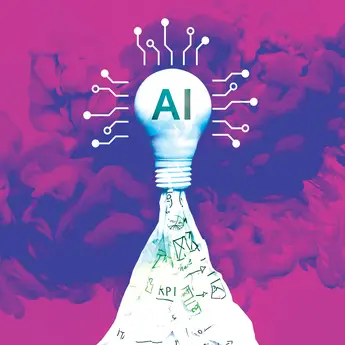Credit: maruco / Shutterstock
As companies aim to take advantage of new technologies such as artificial intelligence, employees need to acquire new skills.
In a 2022 survey, executives estimated that 38% of their workers would need “fundamental retraining or replacement” within three years to address workforce skills gaps, according to new research from the MIT Center for Information Systems Research.
People with AI and data skills are in high demand, and attracting and retaining talent is hard and time-consuming, according to Nick van der Meulen, a research scientist at MIT CISR. “Training is a really important way for us to achieve results. For performance, for retention, for customer experience, and for innovation, it’s the way to go,” van der Meulen said at last fall’s MIT Digital Technology and Strategy Conference.
And in many cases, workers want to be trained. In a Society for Human Resource Management survey, 55% of employees said they need more training to do their job better, and 76% said they would be more likely to stay with a company that offered continuous learning.
To retrain employees, companies need precise insight into workforce skills, including ones that are missing but would contribute to future success, van der Meulen said. To gain such insight, companies such as Johnson & Johnson are using “skills inference” — the process of using AI to analyze employee data to quantify skills proficiency and identify areas for improvement.
Here’s a look at how companies can perform skills inference, and how it can guide workforce planning and employees’ career development.
3 steps for skills inference
Johnson & Johnson began an effort to improve digital expertise among employees in early 2020, starting with the company’s 4,000 technologists before expanding to other business units the following year. The skills inference process comprised three steps:
Skills taxonomy. This step involves defining the skills required “to reimagine business processes and develop future digital offerings,” van der Meulen said. “It’s not about the skills we need to be successful today, but to succeed five to 10 years from now.” Johnson & Johnson identified 41 specific “future-ready” skills, such as master data management and robotic process automation, that were grouped into 11 capabilities.
Skills evidence. Here, an organization selects the right sources of employee data for skills inference. For Johnson & Johnson, these sources were the HR information system, the recruiting database, its learning management system, and one project management platform. Leadership made it clear that skills insights did not factor into employees’ performance reviews and that the information was de-identified and used at an aggregate level to support strategic workforce planning. Employees were free to opt out.
Skills assessment. In the final step, Johnson & Johnson used a large language model to measure each technologist’s proficiency in each of the 41 future-ready skills, using a 0-5 scale. The company also asked workers to rate themselves on the same skills using the same scale; if the two scores deviated by less than one point, the company considered the scores usable. Communicating that the process would be used only for skill development as opposed to performance evaluation helped the company gain worker buy-in and mitigated bias in self-reporting skills, van der Meulen said.
The skills inference process proved powerful at both the personal and enterprise levels. Individual technologists could compare their existing skills with the skills required for a future role they envisioned for themselves and use that information as a catalyst to drive their training. Use of the company’s professional development ecosystem increased 20% after the first round of skills inference; as of March 2024, 90% of technologists had accessed the learning platform.
Meanwhile, executives gained access to heat-map data about technology skills proficiency by geographic region and business line. “This is beneficial for strategic workforce planning,” van der Meulen said. “You can see areas where you’re strong and areas where you’re a little weaker. You may say, ‘Maybe we need to develop our decision science capability in Europe. This is where we should put development dollars.’”
A “career lattice” instead of a career ladder
There are obvious benefits to helping employees identify the skills they need to continue contributing to a company as it undergoes a digital transformation. But van der Meulen offered a word of caution to leaders who want to do this: Not everyone will want to move through the organization the same way.
Many employees seek traditional promotions with higher pay and additional responsibilities, but leaders should “look beyond those career ladders and look for a latticework” of interconnected roles, he said.

AI Executive Academy
In person at MIT Sloan
Register Now
Some will want to make a lateral move to a similar role in another business unit. (This is common at companies the size of Johnson & Johnson, which has about 130,000 employees.) Others will want to take on an emerging title that requires specific new skills — such as AI prompt engineer, a role that was largely nonexistent a year ago. Others may be ready to take a step back, possibly for personal reasons.
For all of these workers, training needs to go above and beyond online learning modules. Workers will need mentorship, hands-on training, and other programs “where people can really put what they want to learn into action right away,” van der Meulen said. Leaders need to be ready to give workers the ability to determine what skills they will learn, when they will learn them, and how they would like to work once they’ve acquired those skills.
Leaders will also need to confront the class of workers who resist change and insist on continuing to complete the same tasks they’ve always done. Van der Meulen recommended showing these individuals what upskilling can mean for them, even if they’re currently effective in their roles and performing well. Specific examples of people who have made exciting career moves can go a long way here.
“People need to understand that skills are dynamic,” van der Meulen said. “What makes you successful today won’t make you successful three years, five years, or 10 years from now.”
Read the research brief: Resolving workforce skills gaps with AI-powered insights




